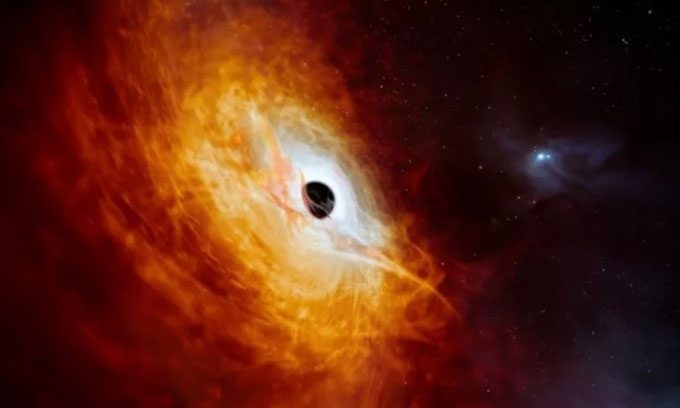A newly discovered quasar breaks multiple records, not only being the brightest quasar ever observed but also the brightest celestial object found.
Quasar J0529-4351 is located so far from Earth that its light took 12 billion years to reach us. Its energy comes from the most ravenous and rapidly growing black hole ever encountered by researchers. This black hole consumes a mass equivalent to that of the Sun every day, according to a study published on February 19 in the journal Nature Astronomy. The supermassive black hole at the center of the quasar is estimated to be 17 to 19 billion times the mass of the Sun. Each year, it “eats” or accumulates gas and dust equivalent to 370 Suns. This makes J0529-4351 500 trillion times brighter than the Sun.

Simulation of record-breaking quasar J0529-4351. (Image: ESA)
“We have discovered the fastest-growing black hole known. It has a mass of 17 billion Suns and consumes more than one Sun each day. This makes it the brightest object in the universe,” said astronomer Christian Wolf from the Australian National University, the lead researcher.
J0529-4351 was identified in data collected four decades ago but was so bright that astronomers could not initially classify it as a quasar. A quasar is a region at the center of a galaxy that contains a supermassive black hole, surrounded by a ring of dust and gas. The extreme conditions in the accretion disk around the black hole heat the dust and gas, making it glow brightly. Additionally, any material in this accretion disk that is not consumed by the black hole is directed toward its poles and ejected as particle jets traveling near the speed of light. As a result, quasars in active galactic nuclei (AGN) can outshine the combined light of billions of surrounding stars.
Even so, J0529-4351 stands out. The light from J0529-4351 comes from the massive accretion disk feeding the supermassive black hole. The research team estimates its diameter to be about 7 light-years, which is approximately 45,000 times the distance from Earth to the Sun.
Initially, J0529-4351 was discovered by the Schmidt Southern Sky Survey telescope in 1980, but researchers took decades to confirm it as a quasar. The large astronomical surveys provided so much data that researchers needed machine learning models to analyze and classify quasars alongside other celestial objects. In fact, J0529-4351 was so bright that models suggested it was a star relatively close to Earth. The research team recognized J0529-4351 as a quasar by using the 2.3m telescope at the Siding Spring Observatory in Australia.
Next, the supermassive black hole at its center is a perfect target for the GRAVITY+ instrument on the Very Large Telescope in Chile. J0529-4351 will also be studied using the Extremely Large Telescope (ELT) currently under construction in the Atacama Desert.


















































